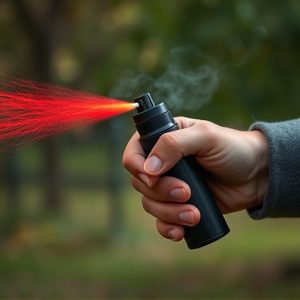Capsaicin Spray: Science, Safety, and Long-Term Effects Explained
Capsaicin, the heat-giving compound in chili peppers, is the active ingredient in pepper spray, whic…….
Capsaicin, the heat-giving compound in chili peppers, is the active ingredient in pepper spray, which works by binding to skin and eye receptors, causing temporary inflammation, pain, redness, and swelling lasting 2-14 hours. Standard concentrations typically disable individuals for 2-4 minutes, while higher ones can last up to 14 hours. This prolonged impact makes capsaicin-based inflammatory crowd control sprays highly effective for deterring aggressive behavior in large gatherings, though they may cause coughing, breathing difficulties, eye irritation, and skin redness in sensitive individuals. Understanding the duration of pepper spray effects is crucial for strategic deployment, aftercare planning, legal compliance, and minimizing risks, with temporary effects lasting 20 minutes to an hour.
“Discover the power of capsaicin-based inflammatory crowd control sprays, a non-lethal solution revolutionizing public safety. This article explores the science behind pepper spray’s effectiveness, delving into its active ingredient, capsaicin, and how it triggers an intense inflammatory response. We examine the duration of its action—uncovering crucial insights on ‘How Long Pepper Spray Effects Last’—as well as its safety profile and legal implications. From emergency responses to crowd management, understand the key considerations and uses of this controversial yet potent tool.”
- Understanding Capsaicin: The Active Ingredient
- The Science Behind Pepper Spray's Inflammatory Effect
- Duration of Action: How Long Does It Last?
- Safety and Side Effects: What to Expect
- Legal Considerations and Use Cases
Understanding Capsaicin: The Active Ingredient
Capsaicin, the active ingredient in pepper spray, is a natural compound derived from chili peppers. It’s what gives peppers their heat and pungent flavor. When used in crowd control sprays, capsaicin activates specific nerve endings in the skin and eyes, leading to temporary disorientation and pain. This effect can last for several minutes, providing enough time for law enforcement or security personnel to gain control of a situation.
The duration of capsaicin’s effects varies depending on factors like concentration, application method, and individual sensitivity. Typically, pepper spray can cause discomfort and immobilize an individual for 3-15 minutes, making it a powerful non-lethal tool for crowd control and self-defense. Understanding how capsaicin works is crucial in recognizing its potential as a safe yet effective measure to manage chaotic situations.
The Science Behind Pepper Spray's Inflammatory Effect
The science behind pepper spray’s inflammatory effect lies in its active ingredient, capsaicin. This compound is found in chili peppers and is responsible for their spicy sensation. When exposed to skin or eyes, capsaicin binds to specific receptors, triggering a cascade of events that lead to inflammation. The body’s natural response includes increased blood flow to the affected area, leading to redness, swelling, and pain—a process that can last anywhere from 2 to 14 hours, depending on the concentration and amount of exposure. This inflammatory reaction is what makes pepper spray an effective crowd control tool, as it temporarily disables individuals, providing time for authorities to intervene.
The duration of pepper spray’s effects varies, but it generally lasts between 2 to 4 minutes for standard concentrations. However, higher concentrations or direct contact can extend the duration up to 14 hours. This longevity is crucial in crowd control scenarios, as it ensures that individuals affected remain incapacitated long enough for law enforcement to secure the area and prevent further disturbances. Understanding the science behind pepper spray’s inflammatory effects and how long these effects persist is essential for both public safety officials and individuals seeking protection in high-risk environments.
Duration of Action: How Long Does It Last?
The duration of action for capsaicin-based inflammatory crowd control spray is a key consideration in its effectiveness as a crowd control measure. Unlike traditional pepper spray, which can wear off quickly, capsaicin spray induces a prolonged inflammatory response. The effects typically last between 3 to 6 hours, depending on the concentration and application method. This extended duration allows for a more sustained disruption of crowds, making it particularly useful in high-risk scenarios where crowd control needs to be maintained over an extended period.
The longevity of capsaicin’s effects is attributed to its ability to disrupt nerve signaling in the affected area. When sprayed onto the skin or eyes, capsaicin binds to nerve endings, causing a persistent inflammatory reaction. This leads to pain, redness, and temporary numbness, ensuring that individuals remain deterred from aggressive behavior for an extended period. The sustained impact makes it an innovative solution for law enforcement and security personnel aiming to manage large gatherings or confront violent crowds effectively.
Safety and Side Effects: What to Expect
Capsaicin-based inflammatory crowd control sprays are designed to disrupt and disperse large gatherings quickly, but users should be aware of potential safety concerns and side effects. These pepper spray alternatives work by targeting the body’s pain receptors, causing temporary discomfort and inflammation. The effects can last for several minutes, providing enough time for law enforcement or security personnel to gain control of the situation.
While capsaicin sprays are generally considered safe when used as intended, they can cause short-term irritation or even more severe reactions in sensitive individuals. Common side effects include coughing, difficulty breathing, eye irritation, and skin redness. It’s crucial to follow usage instructions carefully and ensure adequate training for anyone employing these crowd control measures to minimize risks and maximize effectiveness. Additionally, users should be prepared for the spray’s duration; understanding how long pepper spray effects last can help in strategic deployment and aftercare planning.
Legal Considerations and Use Cases
When considering a Capsaicin-based inflammatory crowd control spray, legal considerations are paramount. These specialized aerosols, designed to temporarily incapacitate individuals through targeted irritation, operate under strict regulations due to their chemical composition and potential impact on human health. Key factors involve local and national laws governing the use of pepper spray, including permit requirements for possession and application, as well as restrictions on who can deploy such devices. Understanding these legal boundaries is crucial for both law enforcement agencies and private security firms aiming to employ this crowd control method effectively while adhering to the law.
Use cases for capsicin-based inflammatory crowd control sprays span diverse scenarios. They have proven valuable in managing large gatherings, such as protests or sporting events, where quick dispersal of a targeted crowd is necessary. Their non-lethal nature makes them a preferred alternative to firearms in situations requiring de-escalation without causing permanent harm. Moreover, the spray’s effects, typically lasting between 20 minutes to an hour, offer a strategic advantage by enabling authorities to control unrest while allowing affected individuals to recover relatively swiftly. This versatility has led many law enforcement agencies worldwide to incorporate these sprays into their crowd management arsenals.
Capsaicin-based inflammatory crowd control sprays have proven effective in various scenarios, offering a non-lethal method of public safety. Understanding the science behind capsaicin’s inflammatory properties and its duration of action—up to several hours—is key to appreciating its role as a crowd control tool. While these sprays have many practical applications, it’s crucial to be aware of potential side effects and legal restrictions to ensure responsible use. By grasping these aspects, we can leverage the benefits of capsaicin-based pepper spray while navigating its complexities.


